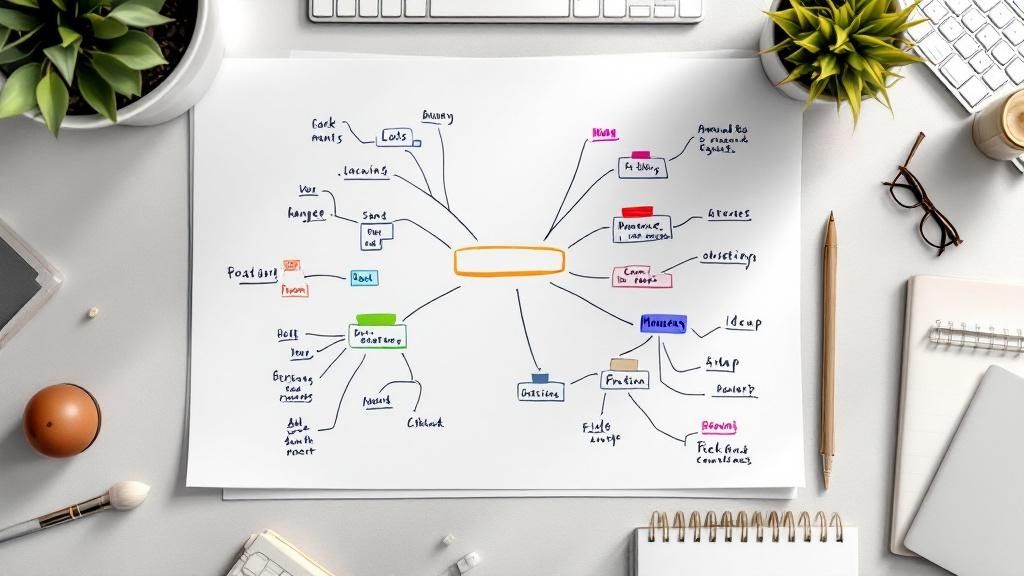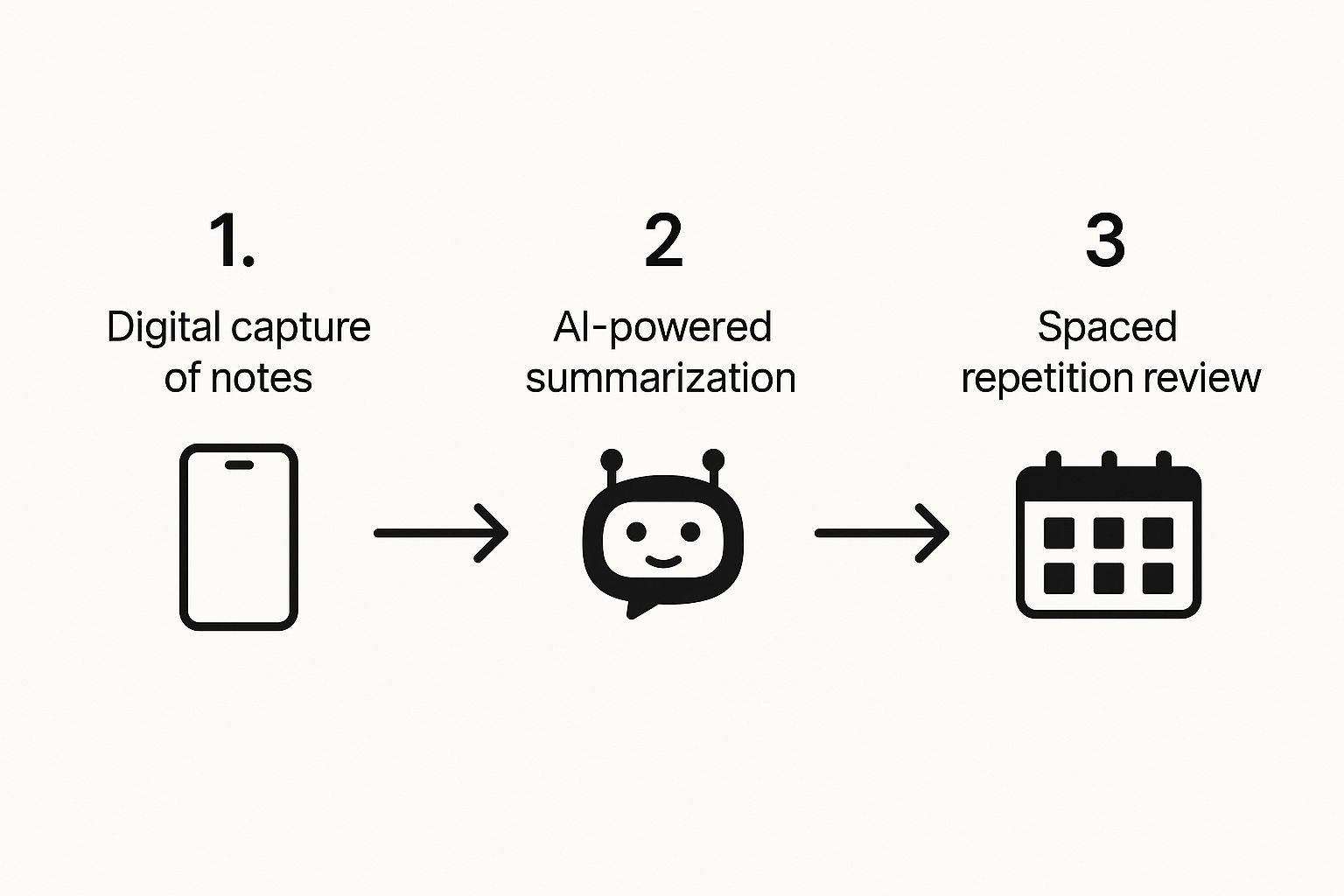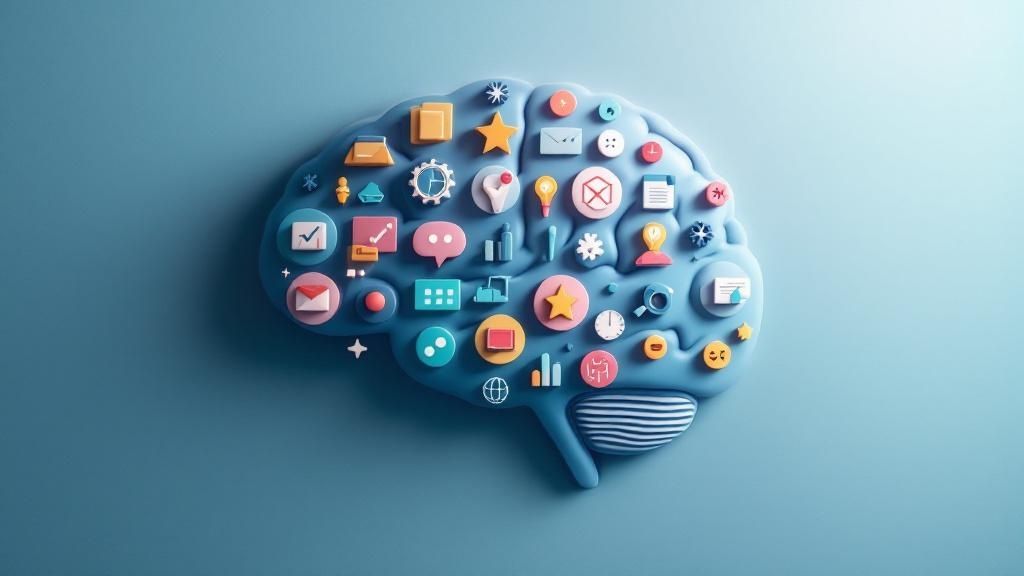Learn How to Process Information Faster Today

If you want to process information faster, you have to stop being a passive consumer. It's time to start actively engaging with the material. Instead of just letting words wash over you, you need to question, connect, and organize what you're hearing or reading in real-time. This mental shift is the secret to boosting your comprehension and making new knowledge stick.
Why Does Processing Information Feel So Slow?
Ever feel like you're drowning in a sea of emails, reports, and articles? If you’re constantly playing catch-up, you're definitely not alone. That feeling of being mentally stuck isn't a personal failing; it's a direct consequence of how our brains are wired and the always-on world we navigate every day.
The first step to fixing this is understanding what's actually going on. Our modern lives have put our brains into a state of divided attention. We're juggling notifications, a dozen open browser tabs, and constant background noise. This makes deep, focused work feel almost impossible and forces our minds to work overtime just to keep up. This relentless information overload creates a massive bottleneck, slowing down how fast we can absorb and understand new things.
The Brain's Natural Speed Limit
Your cognitive processing speed isn't some fixed trait you were born with. It’s a skill. Research shows our ability to process information quickly improves throughout childhood, eventually leveling off around age 15. A fascinating study highlighted this, showing that the brain’s processing power matures at a consistent rate, reaching young adult speeds by our late teens.
This plateau means that as adults, we have to be intentional about training our brains to be more efficient. Feeling slow is usually a symptom of mental clutter and old, ineffective learning habits—not a sign that you can't be quick.
Think of your brain's processing speed like a muscle. If you don't train it with the right techniques, it can't perform at its best. The trick is to switch from being a passive listener to an active participant in your own learning.
A great way to start is by understanding your own mental roadblocks. Engaging in cognitive bias exercises can help you spot and correct the thinking patterns that are holding you back. Once you pinpoint your personal bottlenecks, you can start building better habits and finally feel in control of your information intake instead of overwhelmed by it.
Ready to take that first step? Let's turn your reading list into an efficient learning queue. Download Speak4Me free on iOS and start listening to your documents at a speed that works for you. Note: in-app purchases may apply.
Build Your Mental Framework for Faster Learning

Speak4Me – An illustration of a focused mind ready for faster learning.
Before you even think about hitting the gas pedal on your learning, you need to prep your mind. It’s a lot like a pilot running through a pre-flight checklist. To hit peak performance, you have to get your head in the game first. This means shifting from just passively letting information wash over you to becoming an active, engaged learner.
It all starts with one simple question: Why?
Why are you reading this report? What's the point of this lecture? If you don't have a clear goal, your mind is going to wander, and none of the information will stick. A specific objective acts as a powerful filter, helping your brain instantly sort the important stuff from the noise.
Sharpen Your Focus and Define Your Goal
To really speed up how you process information, you need to be fully present. Mindfulness isn't just for a yoga mat; it’s an incredibly practical tool for sharpening your focus. Before you dive into a new topic, take a minute to quiet the chaos.
Close those extra browser tabs. Silence your phone. Give the material you're about to tackle your full, undivided attention.
Here’s a real-world example: imagine you’ve got exactly one hour to get ready for a make-or-break client meeting. The amateur move is to just skim old emails and reports. The pro move? Set a laser-focused goal.
Something like: "I need to find three key pain points the client mentioned last quarter and one recent success story."
See the difference? This targeted approach completely changes how you engage with the material. You’re not just reading anymore—you’re on a mission, hunting for specific intel.
Your brain is the most powerful search engine you'll ever use. Give it a precise query—your goal—and it will sift through information with incredible efficiency. Without a clear goal, it's like searching the internet without keywords. You'll just browse aimlessly.
From Passive Consumption to Active Engagement
The gap between a slow learner and a fast one often boils down to one thing: engagement. A huge part of building a solid mental framework for faster learning is actively working on your memory. Taking some time to learn how to improve memory retention can pay huge dividends, as these techniques are at the very core of an active learning mindset.
Research from the Clay Center at Massachusetts General Hospital shows that for the 2-5% of children with clinically slower processing speeds, it just takes their brain longer to make sense of things. While it’s not a learning disability, simple adjustments like clear instructions and focused tasks make a world of difference. You can borrow this exact principle by giving your brain a single, clear purpose for every learning session.
Once you’ve done this mental prep work, you’ve built the foundation. Now you are ready to use a tool like Speak4Me to accelerate the actual intake.
Transform your documents into audio and listen with that focused intent you just cultivated. Download Speak4Me free on iOS to start building these high-performance habits today (note: in-app purchases may apply).
And for more great strategies on making information stick, don't miss our guide on 5 study tips to pass any test.
Adopt Active Engagement Strategies

Speak4Me – A visual showing active engagement strategies for faster learning.
Let's be honest. We've all been there—passively highlighting a wall of text or mentally checking out during a meeting. Those are guaranteed ways to slow your learning to a crawl. If you really want to process information faster, you have to switch from being a passive bystander to an active participant.
This isn't just about "paying more attention." It's about deliberately forcing your brain to interact with the material. Doing this builds stronger mental connections, making it easier and quicker to recall what you’ve learned when you actually need it.
Use a System to Structure Your Learning
Jotting down random notes or highlighting whatever looks important might feel productive, but it usually leaves you with a jumble of disconnected facts. To really speed things up, you need a system. Two of the most reliable methods are SQ3R and the Cornell Method. They’ve been around for ages because they work.
The SQ3R Method (Survey, Question, Read, Recite, Review) is a lifesaver when you're facing a dense report, a textbook chapter, or any heavy piece of writing. Here’s how it breaks down:
Survey: First, just skim. Look at headings, summaries, and images to get the lay of the land.
Question: Turn those headings into questions. What do you need to find out?
Read: Now, read with a purpose—to find the answers to your questions.
Recite: After each section, pause and summarize what you just read in your own words. Say it out loud if you have to.
Review: Finally, go back over your notes and the material to lock it all in.
This turns reading into an active investigation. You're essentially interviewing the text, which primes your brain to spot and hang onto the most critical information.
When you actively question information as you consume it, you’re not just memorizing facts. You're building a mental map, connecting new ideas to what you already know, which is the cornerstone of rapid comprehension.
Revolutionize Your Note-Taking
When it comes to meetings, lectures, or even listening to podcasts, the Cornell Method is a fantastic tool for taking structured, useful notes. Just divide your page into three sections: a large area for your main notes, a smaller column on the left for cues or questions, and a summary section at the bottom.
This simple layout is powerful because it forces you to process the information multiple times. First, you take the notes. Then, you pull out the key ideas for the cue column. Finally, you synthesize everything into a summary. It’s an incredibly efficient workflow.
Having an organized mental process matters. Research shows that our information processing speed is a global cognitive function, meaning it’s tied to everything from simple motor tasks to complex reasoning. A unified speed factor in the brain links these abilities, so adopting more structured thinking can have a surprisingly broad impact.
This is especially true for complex material. For instance, knowing how to read research papers for faster understanding can save you a ton of time. When you start combining these methods with other smart habits, your ability to learn quickly can really take off. If you're looking for more ideas, check out our guide on how to be more productive.
Whether you’re reading, listening, or sitting in a meeting, these active strategies make learning more engaging and far more efficient.
Train Your Brain with the Right Tech
Let's be honest, our brains can only do so much on their own. But when you pair your natural abilities with the right technology, you can start to push past those old limits. This is about completely rethinking how you learn and absorb information.
I'm not talking about reading faster. I'm talking about turning any dense report, long-winded email, or must-read article into your own personal audiobook. With a quality text-to-speech app like Speak4Me, your commute, your workout, or even your household chores can become productive learning time. You get to break free from the screen and absorb information on your own terms.
Get Comfortable with Variable Speed Playback
The real magic here is getting the hang of variable speed playback. Most of us listen to audio at the default 1.0x speed, which is often way slower than our brains can actually process. By nudging that speed up little by little, you train your auditory processing skills—it's a lot like how a runner uses interval training to get faster.
You can't just crank it to 2.0x on day one and expect to catch everything. That’s a recipe for frustration. The trick is to gradually increase the speed, pushing yourself just enough to feel a little challenged but not so much that you lose the thread. Over time, your brain adapts. What initially sounds like a chipmunk starts to sound perfectly normal. It's this deliberate practice that helps your brain to process information at a higher velocity.
The image below shows how Speak4Me puts you in the driver's seat.

Speak4Me – A screenshot of the app's variable speed playback control, allowing users to train their auditory processing.
With a simple slider, you have complete control to fine-tune the speed and match it to your training goals for the day.
Your Plan to Increase Auditory Processing Speed with Speak4Me
Ready to give it a shot? Here's a practical, week-by-week plan to get comfortable with faster listening. The goal is to build momentum without getting overwhelmed.
Follow this progressive plan to train your brain for faster information intake.
Week | Listening Speed | Daily Practice | Goal |
|---|---|---|---|
Week 1 | 1.0x - 1.2x | Listen to 20 minutes of easy content, like news or articles. | Get comfortable with a slightly faster pace. |
Week 2 | 1.3x - 1.5x | Increase to 30 minutes with more complex stuff, like reports. | Sharpen your focus and start catching key details. |
Week 3 | 1.6x - 1.8x | Keep it at 30 minutes of complex material. Rewind if you miss something. | Maintain solid comprehension at a higher speed. |
Week 4 | 1.8x - 2.0x | Challenge yourself with 30-45 minutes on any material you need to learn. | Make faster listening feel natural and effortless. |
This isn't just about speed—it's about comprehension at speed. If you find yourself losing the plot, don't worry. Just dial the speed back by 0.1x for a day or two before pushing forward again. This is a marathon, not a sprint.
By following a structured plan, you're actively helping your brain build new neural pathways. Before you know it, faster processing will feel like second nature. You'll go from being a passive consumer of information to an active, efficient learner.
Stop just reading. Start listening with purpose. Download Speak4Me free on iOS to begin your training. Note: in-app purchases may apply.
Synthesize What You Learn Instantly

Speak4Me – A visual of mind mapping, a key technique for synthesizing information.
It’s one thing to get through your reading list quickly, but it's another thing entirely to actually understand it. Speed without comprehension is just a fast track to forgetting everything you just consumed. The real goal is to turn that firehose of information into something you can actually use.
This is where the magic happens. True learning kicks in when you start connecting the new stuff to what you already know. You’re not just trying to recall a specific statistic from a report; you’re figuring out what that statistic means for the project you’re working on. This step is what makes the knowledge stick.
From Raw Data to Real Insight
Two of the most effective ways to really nail down new information are mind mapping and a neat little trick called the Feynman Technique. Both methods force you to break things down and put them back together in your own words, which is a powerful way to lock in learning.
Mind Mapping: This is a visual person’s dream. You put the main idea in the middle and branch out with the key concepts and supporting details. It’s fantastic for seeing how everything fits together—often revealing connections you wouldn't have spotted otherwise.
The Feynman Technique: Don’t let its simplicity fool you; this one is a powerhouse. You take a complex idea and try to explain it in the simplest terms possible, like you’re talking to a fifth-grader. The moment you stumble or have to use jargon, you’ve pinpointed exactly what you don't understand yet.
The real test of knowing something isn't whether you can recite a complicated definition. It's whether you can explain it so simply that anyone gets it. That's when you know the information is truly yours.
Your AI-Powered Assistant for Synthesis
This is exactly where a tool like Speak4Me comes into play. It’s built for more than just listening faster. The integrated AI chat, ChatWithMe, is designed to help you digest and make sense of information right on the spot.
Instead of just passively listening, you can actively engage with the material by asking questions directly about the document you've uploaded.

Speak4Me – ChatWithMe feature allows you to ask questions about your documents for instant synthesis.
Being able to instantly ask your documents questions is a complete game-changer. A static PDF suddenly becomes an interactive partner.
Picture this: you've just finished listening to a dense, 50-page market analysis. Normally, you’d have to spend another hour picking through it for the highlights. With Speak4Me, you can just ask:
“What are the key takeaways from this report?”
“List the top three risks mentioned in the 'Financial Outlook' section.”
“Explain what they mean by ‘customer acquisition cost’ in this context.”
You get to absorb the information at double speed, then immediately question, clarify, and summarize the most important parts. For students staring down a mountain of reading before an exam, this workflow can be a lifesaver. When you blend these tech-savvy approaches with proven study habits, the results can be pretty dramatic. For more on that, take a look at our guide on 5 study tips to pass any test.
This combination of speed-listening and AI-powered synthesis doesn't just help you learn faster; it helps you understand on a much deeper level.
Your Questions on Faster Processing Answered
As you start experimenting with these methods, some questions are bound to come up. It's totally normal. Getting straight answers to common sticking points is the best way to keep moving forward. Let's tackle a few of the questions we hear most often.
Is Speed Reading a Real Thing?
Ah, the big one. Everyone wants to know if speed reading is the magic bullet. The short answer? Not in the way most people think.
While you can train yourself to scan words much faster, that speed almost always comes at the expense of understanding. You might blaze through a page, but did any of it actually stick? It’s a classic case of quantity over quality.
A much smarter approach is to become an efficient reader. This means you learn to skim for the big picture first, then dive deep only where it counts. An app like Speak4Me, which has text-to-speech, is fantastic for this because you can gradually bump up the playback speed without that sudden drop-off in comprehension.
The goal isn't just to see words faster; it's to understand ideas faster. Sacrificing comprehension for raw speed is a trade-off that rarely pays off in the long run.
How Much Do Sleep and Diet Really Matter?
They matter—a lot. Think of it this way: all the learning strategies in the world are like high-performance software. But if the hardware—your brain and body—is sluggish and poorly maintained, that software will never run properly.
Good, consistent sleep is non-negotiable. It's when your brain consolidates memories and clears out the mental junk, letting you wake up sharp and focused.
Likewise, what you eat directly fuels your brain. A diet rich in brain-friendly nutrients, like omega-3 fatty acids, keeps your cognitive gears lubricated. You simply can't build elite learning habits on a foundation of junk food and exhaustion.
How Long Until I See Real Improvements?
This is probably the most common question we get, and the honest answer is all about consistency. You’ll likely feel a difference almost immediately—just setting a clear goal before you read can make you feel more focused within the first week.
But for those bigger, measurable gains, like listening comfortably at 1.5x or 2.0x speed, you need to give it a little time. Stick with it. If you practice consistently for about three to four weeks, you'll see a noticeable shift. Your brain will adapt, and that new, faster pace will start to feel normal. It's an investment that pays off big time in your daily productivity.
Ready to put these answers into action and build your own high-speed learning system? With Speak4Me, you can turn any text into audio and start training your brain today.
Download Speak4Me free on iOS and discover how much faster you can learn. Note: in-app purchases may apply.
Try Speak4Me for Free
